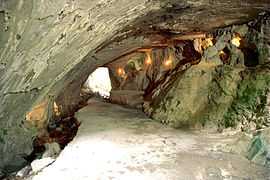Zugarramurdi
From Wikipedia, the free encyclopedia
| Zugarramurdi | ||
|---|---|---|
| Municipality | ||
 | ||
| ||
 Zugarramurdi | ||
 Zugarramurdi | ||
| Coordinates: 43°16′10″N 1°32′30″W / 43.26944°N 1.54167°W | ||
| Country |
| |
| Autonomous Community |
| |
| Province | Navarre | |
| Comarca | Baztan (valley) | |
| Government | ||
| • Mayor | Lázaro Dainciart Iribarren | |
| Area | ||
| • Total | 5.6 km2 (2.2 sq mi) | |
| Elevation(AMSL) | 205 m (673 ft) | |
| Population (2012) | ||
| • Total | 243 | |
| • Density | 43/km2 (110/sq mi) | |
| Time zone | CET (UTC+1) | |
| • Summer (DST) | CEST (GMT +2) (UTC+2) | |
| Postal code | 31710 | |
| Area code(s) | +34 (Spain) + 948 (Navarre) | |
| Website | www.zugarramurdi.es | |
Zugarramurdi is a town and municipality located in the province and autonomous community of Navarre in northern Spain It passed into history as the setting of alleged occult activity featured in the infamous Basque witch trials held in Logroño in the seventeenth century. The town is home to the Basque witch museum and the Cuevas de las Brujas (Witch caves). Every year, spectacular fires are lit in the caves near Zugarramurdi for the celebration of the ‘day of the witch’ on the summer solstice.[1]
Gallery
-

Street of Zugarramurdi
-

Typical architecture
-

Asunción Church
-

The "Cave of the Witches" near Akelarre in Zugarramurdi
-

Akelarre host in 2009
References
External links
- Homepage of Zugarramurdi
- ZUGARRAMURDI in the Bernardo Estornés Lasa - Auñamendi Encyclopedia (Euskomedia Fundazioa) (Spanish)
Coordinates: 43°16′N 1°32′W / 43.267°N 1.533°W
This article is issued from Wikipedia. The text is available under the Creative Commons Attribution/Share Alike; additional terms may apply for the media files.
